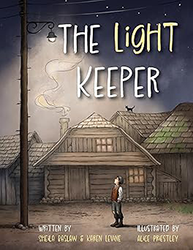Reading Itzhak: A Boy Who Loved the Violin is an experience much like watching and listening to a powerful musical performance. A compelling plot, striking colorful images — even musical notes swirling throughout the text — bring the virtuoso violinist Itzhak Perlman’s story to life. Newman’s melodic text and Halpin’s striking pictures weave a story of a gifted child who faced obstacles with incredible persistence.
Born in Palestine in 1945, Itzhak grew up in the young state of Israel, living with his parents in Tel Aviv. Halpin shows the musician as a baby cradled by his mother as he and his parents look out the window of their modest apartment at the vibrant street life below. Itzhak’s father moves the dial on the family’s radio; although their apartment is “tiny,” with “no bathroom of its own,” music will be a constant in their home. The music is eclectic, including the Jewish ingredients of “soulful cantorial chants,” and “lively klezmer folk tunes,” but also the classical repertoire. Text and pictures communicate the intensity of Itzhak’s senses; as he hears the beauty of the notes, he sees “a vivid rainbow of colors in his mind.” Fortunately, his understanding parents chose to buy him a toy violin, in spite of their financial limitations.
After this beginning, readers learn that Itzhak is not only a gifted artist but a child with a unique personality. He becomes disappointed and frustrated when his skills fail to reach his own high standards. Tragedy strikes when he contracts the polio virus which, in the years before a vaccine, took lives and left many patients with disabilities. Halpin conveys the sense that each case of the disease is cruelly personal by showing a hospital room full of beds covered in blue; only Itzhak has a red blanket. Newman enumerates the details of his struggle to recover, “raising his arms over his head, holding a book, grasping a pencil,” as the beginning of a long process. His frustrating need to convince skeptics that a violinist could perform while sitting down is poignant. Itzhak understands that there are goals which he will never reach, but others which bring him fulfillment and joy.
Halpin alternates portrayals of Itzhak in everyday life with ones of him playing the violin, “living, breathing, becoming the melody” in a transformative state. Yet the Itzhak taking a free moment to watch construction workers on the job is the same boy seated in a bright spotlight, surrounded by indigo and white silhouettes of the musicians accompanying him in his imagination. Children reading the book will come away with a picture of genius expressed through limits, and the message that acceptance of limits and determination to succeed are both parts of any life. Perlman’s career will be extraordinary, and the challenges he faced may be easily understood by the book’s readers.
Itzhak: A Boy Who Loved the Violin is highly recommended and includes a detailed and helpful “Author’s Note,” an “Illustrator’s Note,” text citations, and a timeline of Perlman’s life.
Emily Schneider writes about literature, feminism, and culture for Tablet, The Forward, The Horn Book, and other publications, and writes about children’s books on her blog. She has a Ph.D. in Romance Languages and Literatures.




